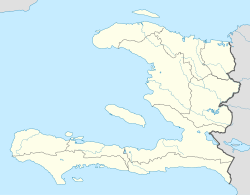Berthier—Montcalm was a federal electoral district in Quebec, Canada, that was represented in the House of Commons of Canada from 1988 to 2004.
Fort Rivière is a ruined mountain fort on the summit of Montagne Noire, Saint-Raphaël Arrondissement. It's located on the north coast of Haiti and to the south of Grande-Rivière-du-Nord and 20 miles south of Cap-Haïtien. It was a French bastion fort that was the site of the defeat of the Haitian rebel force called the Cacos on 17 November 1915.
A French creole, or French-based creole language, is a creole language for which French is the lexifier. Most often this lexifier is not modern French but rather a 17th-century koiné of French from Paris, the French Atlantic harbors, and the nascent French colonies. French-based creole languages are spoken natively by millions of people worldwide, primarily in the Americas and on archipelagos throughout the Indian Ocean. This article also contains information on French pidgin languages, contact languages that lack native speakers.
Jules Solime Milscent was a Haitian fabulist, poet, and politician. He was a mulatto, born in Grande-Rivière du Nord to a white French father and a free black mother. Educated in France, Milscent co-founded the periodical L'Abeille Haytienne and served in several government positions, including a seat on the commission to draft the Haitian Civil Code. He is best known for his fables, such as:

An arrondissement is a level of administrative division in Haiti.

Bahon, sometimes called Bohon, is a commune in Grande-Rivière-du-Nord Arrondissement in the Nord, department of Haiti. It is located on the Grand Rivière du Nord (river). It was formerly (1915) located on the railroad south from Cap-Haïtien.
Limbe or Limbé may refer to:

Pestel is a commune in the Corail Arrondissement, in the Grand'Anse department of Haiti. It has 36,138 inhabitants. The commune also includes the Cayemite Islands.

Acul-du-Nord is a commune in the Acul-du-Nord Arrondissement, in the Nord department of Haiti.
Grande Rivière du Nord is a small coastal river that has its mouth in the Atlantic Ocean located in the Nord department of Haiti.

Jean-Baptiste Chavannes was a Haitian abolitionist and soldier.

The communal section is the smallest administrative division in Haiti. The 145 communes are further divided into 571 communal sections.

Three Bays Protected Area is the second largest declared protected area in Haiti after the Port Salut/Aquin Protected Area. The Three Bays Protected Area has a boundary perimeter of approximately 170 km (110 mi) encompassing over 75,000 ha. The area contains some of the most extensive and healthiest fringing and barrier coral reefs, seagrass beds, and mangrove forests in the country, which provide critical coastal protection and ecosystem services for its seaside communities. The area is biologically productive but extremely overfished by many regional communities.






